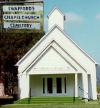Historic Sites in Southeast TN
from users
11 items | Created 07/12/2012
Use/Customize | Download | Print

Known as the "Gateway to the Deep South", the control of Chattanooga, TN was a vital goal for both the Union and the Confederacy during the Civil War. In 1863, they fought for control, and the battlefields at Lookout Mountain and Chattanooga preserve this historic struggle for control in what were some of the most vicious conflicts of the Civil War.
The Sequatchie Valley Historical Association, formed in 1984, set a goal to build an exact full size replica of the original coal company store "Commissary". Hundreds of donated mining artifacts are on display inside the museum. The museum currently houses the largest collection of regional historic coal mining photographs in the state of Tennessee.
Since 1824, Ketner’s Mill has been a place that shaped the lives of the Ketner family and those who settled in the Sequatchie Valley of Southeast Tennessee. The story is one of beginnings, growth, progress and community all told at once through Ketner’s Mill.

The Jasper Regional History Museum harbors a collection of memorobillia and artifacts from the county's Native American history, the Civil War & the Great Depression . Whether you live in Marion County or you are passing through the area, this is a good place to check out if you have an interest in the colorful history of small towns and their environs.
_sm.jpg)
The Grundy County Historical Society is dedicated to preserving the history of the Grundy County, Tennessee area and the genealogy of its people. The Society is a non-profit organization devoted to genealogy and historic preservation.
To escape the heat of one hot summer day in 1833, Beersheba Porter Cain of McMinnville followed a mountainous Grundy County pathway to a chlybeate spring that would eventually come to bear her name and, along with the amazing view of the Collins River Valley below, would inspire the creation of a summer resort that is still very much intact today and known as the Beersheba Springs Hotel.
Visit the site of the famous trial between creationism and evolution, a debate that continues today. The Scopes Trial of 1925, placed a teacher on trial for teaching evolution in the classroom and has continued to retained a growing worldwide inerest into the present day.

An original log church was built by Thomas Swafford in the 1820s and was served by circuit riding preachers. The lumber of a second building is said to have been used to build barracks for Federal soldiers during the Civil War. The current structure was built in 1912 as a part of the Methodist Episcopal Church, South.

Built in 1872, this house and its outbuilding once belonged to the Confederate veteran Dr. James Ross. In the 1940's the house served as the county hospital and many of Pikeville's current residents were born in the rooms of this house.

This two-story 1815 home next to the courthouse in Pikeville, TN was owned by John Bidgeman. Bridgeman was a local civic and business leader who outfitted a company of Confederate infantry from Bledsoe County.

Established 1848 through the efforts of Elihu Burritt, a blacksmith who intended that the youth of this community should get the benefits of education denied to him. It closed its doors in 1939 as a result of the development of the public school system and improvement of communication facilities.
 button to add them to your planner, then Print or Download your itinerary for the driving directions to each stop on your trip plan.
button to add them to your planner, then Print or Download your itinerary for the driving directions to each stop on your trip plan. 



 Create a Trip!
Create a Trip!


